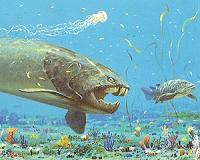| . |  |
. |
Cambridge MA (SPX) May 27, 2010 One way that geologists try to decipher how cells functioned as far back as 3 billion years is by studying modern microbial mats, or gooey layers of nutrient-exchanging bacteria that grow mostly on moist surfaces and collect dirt and minerals that crystallize over time. Eventually, the bacteria turn to stone just beneath the crystallized material, thereby recording their history within the crystalline skeletons. Known as stromatolites, the layered rock formations are considered to be the oldest fossils on Earth. Deciphering the few clues about ancient bacterial life that are seen in these poorly preserved rocks has been difficult, but researchers from MIT's Department of Earth, Atmospheric and Planetary Sciences (EAPS) and the Russian Academy of Sciences may have found a way to glean new information from the fossils. Specifically, they have linked the even spacing between the thousands of tiny cones that dot the surfaces of stromatolite-forming microbial mats - a pattern that also appears in cross-sectional slices of stromatolites that are 2.8 billion years old - to photosynthesis. In a paper published in the Proceedings of the National Academy of Science, the researchers suggest that the characteristic centimeter-scale spacing between neighboring cones that appears on modern microbial mats and the conical stromatolites they form occurs as a result of the daily competition for nutrients between neighboring mats. In addition to helping scientists put a better range on when photosynthesis started, the research provides a new technique for interpreting the patterns of these ancient fossils. By analyzing the length of the triangular patterns seen in an ancient stromatolite, for example, geologists can now infer more details about the environment in which the microbial mat lived, such as whether it lived in still or turbulent water. Until now, no one had explored the consistent one-centimeter spacing that appears between the tiny cones featured on microbial mats and conical stromatolites that grow in the hot springs of Yellowstone National Park, and at other locations around the world. Lead author and EAPS graduate student Alexander Petroff and EAPS professors Daniel Rothman and Tanja Bosak proposed that the pattern was not coincidental and could pertain to a biophysical process, such as how the bacteria compete for nutrients. By studying the physics of photosynthesis, the researchers formed a better understanding of how a mat consumes nutrients from its surroundings over the course of a day, and then metabolizes, or breaks down, those nutrients for energy. During the daytime, a mat takes in nutrients like inorganic carbon from its immediate surroundings and uses energy from sunlight to build sugars and new bacteria. As these nutrients become locally depleted, the mat starts to consume nutrients from larger distances. At nighttime when it is dark and photosynthesis is not possible, nutrients return to the water immediately surrounding the mat. The researchers reasoned that in order to avoid direct competition for nutrients, the spacing between mats must be influenced by diffusion, or how molecules spread out over time. In this case, diffusion is itself influenced by the amount of time a mat is metabolically active, which varies over the course of a day due to changes in sunlight. Therefore, the spacing between cones records the maximum distance that mats can compete with one another to metabolize nutrients that are spread by diffusion and later replenished at night. After testing this theory on cultures in the lab, the researchers confirmed their hypothesis through fieldwork in Yellowstone, where the centimeter spacing between mats corresponds to their metabolic period of about 20 hours. That the spacing pattern corresponds to the mats' metabolic period - and is also seen in ancient rocks - shows that the same basic physical processes of diffusion and competition seen today were happening billions of years ago, long before complex life appeared. Petroff and his colleagues are currently researching why biological stromatolites form cones instead of other shapes.
Share This Article With Planet Earth
Related Links Massachusetts Institute of Technology Explore The Early Earth at TerraDaily.com
 On The Backs Of Fishes
On The Backs Of FishesMoffett Field CA (SPX) May 20, 2010 A mass extinction of fish 360 million years ago hit the reset button on Earth's life, setting the stage for modern vertebrate biodiversity, a new study reports. The mass extinction scrambled the species pool near the time at which the first vertebrates crawled from water towards land, University of Chicago scientists report. Those few species that survived the bottleneck were the evolution ... read more |
|
| The content herein, unless otherwise known to be public domain, are Copyright 1995-2010 - SpaceDaily. AFP and UPI Wire Stories are copyright Agence France-Presse and United Press International. ESA Portal Reports are copyright European Space Agency. All NASA sourced material is public domain. Additional copyrights may apply in whole or part to other bona fide parties. Advertising does not imply endorsement,agreement or approval of any opinions, statements or information provided by SpaceDaily on any Web page published or hosted by SpaceDaily. Privacy Statement |